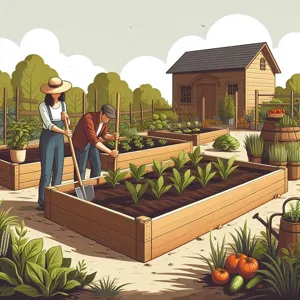Transforming your outdoor space into a flourishing oasis begins with a simple yet rewarding project: building your dream raised garden bed.
Whether you’re an experienced gardener or a beginner with a budding green thumb, raised garden beds offer numerous benefits, from improved soil drainage to easier access for planting and harvesting. They not only enhance the aesthetic appeal of your garden but also provide a controlled environment for your plants to thrive. In this step-by-step guide, we will walk you through the entire process—from selecting the perfect location and materials to planting your favorite flowers, herbs, or vegetables. With our detailed instructions and helpful tips, you’ll be well on your way to creating a vibrant garden that reflects your personal style and brings joy to your gardening experience. Let’s dig in and get started on your journey to cultivating your dream garden!
1. Introduction to Raised Garden Beds

Raised garden beds are a fantastic way to cultivate a thriving garden, offering a multitude of benefits for both novice and seasoned gardeners alike. By elevating your planting area, these beds create an ideal growing environment that maximizes space, improves drainage, and enhances soil quality. Whether you’re looking to grow vibrant vegetables, fragrant herbs, or stunning flowers, a raised garden bed can be tailored to fit your specific needs and aesthetic preferences.
One of the key advantages of raised garden beds is their ability to provide better control over soil conditions. By filling your bed with a custom soil mix, you can ensure that your plants receive the optimal nutrients, moisture retention, and aeration they require for healthy growth. Additionally, the height of the beds often makes gardening more accessible, reducing the strain on your back and knees.
Beyond functionality, raised garden beds also offer a visually appealing element to your outdoor space. They can be constructed in various shapes, sizes, and materials, allowing you to create a personalized garden that complements your home and landscape. From rustic wooden frames to sleek metal designs, the options are endless.
In this step-by-step guide, we will walk you through the process of building your dream raised garden bed, from selecting the right materials to planting your first seeds. Whether you have a sprawling backyard or a cozy balcony, it’s time to roll up your sleeves and embark on an exciting gardening adventure!
2. Benefits of a Raised Garden Bed
When it comes to gardening, raised garden beds offer a multitude of benefits that can transform your gardening experience from the ground up. One of the primary advantages is improved soil quality. By elevating your plants above the natural ground level, you have complete control over the soil composition. This allows you to create a nutrient-rich environment tailored to the specific needs of your plants, whether they thrive in sandy loam or a more clay-like structure.
Additionally, raised garden beds facilitate better drainage. Traditional gardening can often lead to waterlogged soil, but with a raised structure, excess water can easily flow away, ensuring that your roots stay healthy and well-aerated. This is especially beneficial in areas prone to heavy rainfall, as it minimizes the risk of root rot and other moisture-related issues.
Moreover, the height of a raised garden bed can reduce the strain on your back and knees. No more bending down or crouching to tend to your plants—simply stand and enjoy your gardening tasks. This ergonomic advantage makes gardening accessible for everyone, from the seasoned gardener to those who may have mobility challenges.
Raised beds can also help deter pests. The elevation makes it more challenging for certain critters, like rabbits and groundhogs, to access your plants. Plus, you can easily incorporate protective measures such as row covers or netting without disrupting the surrounding landscape.
Finally, let’s not overlook the aesthetic appeal of raised garden beds. They create clean lines and structured spaces in your yard, enhancing its overall visual appeal. You can customize the design and materials to match your style, whether it’s rustic wooden frames or sleek metal containers.
In summary, raised garden beds are more than just a gardening trend; they are a practical solution that offers enhanced soil quality, better drainage, ergonomic benefits, pest deterrence, and a touch of beauty to your garden. With these advantages in mind, you’ll be eager to embark on your journey to build the perfect raised garden bed!
3. Choosing the Right Location

Choosing the right location for your raised garden bed is a critical step in ensuring a thriving garden that yields a bountiful harvest. The ideal spot will be influenced by several factors, including sunlight, accessibility, and soil drainage.
**Sunlight:** Most vegetables and flowering plants crave sunlight, so it’s essential to select a location that receives at least six to eight hours of direct sunlight each day. Observe your yard throughout the day to identify sunny spots, and take note of any areas that may be shaded by trees, fences, or buildings. If you have limited sun exposure, consider opting for shade-tolerant plants that can thrive in lower light conditions.
**Accessibility:** Your garden should be easily accessible for regular maintenance, watering, and harvesting. Choose a location that is convenient for you to reach, ideally close to your kitchen or living area. This proximity will not only make it easier to tend to your plants but also encourage you to engage with your garden more frequently. Ensure that the path to your garden bed is clear and that you can easily maneuver tools or watering cans without obstruction.
**Soil Drainage:** Good drainage is vital for healthy plant growth, as standing water can lead to root rot and other issues. To assess drainage, watch how water behaves in the area after a rainfall. If you notice puddles forming or the ground remains soggy for an extended period, you may need to consider elevating your garden bed further or amending the existing soil with organic matter to improve its drainage capabilities.
Take the time to carefully evaluate these factors before finalizing your garden bed’s location. A well-placed raised garden bed not only enhances the aesthetics of your outdoor space but also sets the stage for a successful gardening experience. With the right location secured, you’ll be well on your way to growing your dream garden!
4. Selecting Materials for Your Garden Bed
Choosing the right materials for your raised garden bed is a crucial step that will significantly influence the longevity, aesthetics, and overall health of your garden. The materials you select will not only define the structure of your garden bed but also contribute to the growing environment for your plants. Here are some options to consider, along with their pros and cons.
**wood:**
Wood is the most popular choice for building raised garden beds, thanks to its natural appearance and ease of use. Cedar and redwood are excellent options due to their resistance to rot and insects, which can help your garden bed last for many years. However, softer woods like pine can be more affordable but may require replacement sooner. When using wood, it’s essential to ensure that it’s untreated, as chemicals in treated wood can leach into the soil and harm your plants.
**Metal:**
For a modern look and extreme durability, consider using metal, such as galvanized steel or aluminum. These materials are resistant to weathering and pests, making them a long-lasting choice. Metal beds can also retain heat, which may benefit certain plants that thrive in warmer soil. However, be cautious of the potential for metal to heat up in direct sunlight, which could lead to overheating roots in extreme climates.
**Bricks or Concrete Blocks:**
If you’re looking for a more permanent solution, bricks or concrete blocks can create a sturdy and aesthetically pleasing raised garden bed. While these materials are durable and provide excellent drainage, they can be more labor-intensive to install. Additionally, ensure that any concrete blocks are free from harmful chemicals, as some can leach into the soil.
**Composite Materials:**
Recycled plastic or composite materials are becoming increasingly popular for raised garden beds. These materials mimic the look of wood without the risk of rotting or splintering, making them a low-maintenance option. They are typically more expensive but offer excellent durability and environmental benefits.
As you select materials, consider the size and design of your raised garden bed, as well as your personal style and budget. Ensure that whatever you choose will provide a safe and healthy environment for your plants to thrive. With the right materials in hand, you’re one step closer to creating the garden of your dreams!
5. Designing Your Garden Bed: Size and Shape Considerations

Designing your garden bed is one of the most exciting steps in the process of creating your dream raised garden. The size and shape of your garden bed play a crucial role in not only its functionality but also its aesthetic appeal. Before you dive into construction, take a moment to envision the space you have available and how you want it to look in your outdoor environment.
First, consider the size of your garden bed. A common width for raised beds is 4 feet, as this allows easy access to the center without the need to step into the bed itself. This width facilitates maintenance tasks like weeding, harvesting, and watering while also ensuring that plants grow healthily without overcrowding. The length can vary based on your available space; however, keeping it between 4 to 8 feet is ideal for managing the garden comfortably.
Next, think about the height of your raised bed. Taller beds, usually between 12 to 24 inches, can be easier on your back and help with drainage in heavy soils. However, if you’re planting deep-rooted vegetables like tomatoes or carrots, consider a deeper bed to accommodate their growth.
Once you’ve settled on size, it’s time to decide on the shape. Traditional rectangular beds are popular, but don’t be afraid to get creative! Curved edges can soften the look of your garden and blend seamlessly into a more natural landscape, while tiered designs can add depth and visual interest. Circular or hexagonal beds can also be a striking focal point in your yard, allowing you to plant in a way that maximizes sun exposure and airflow.
Finally, think about how your garden design fits into your overall landscape. Will it be a standalone feature, or will it complement existing paths, patios, or flower beds? Drawing a simple sketch can help you visualize your ideas and ensure that your raised bed will harmonize with the surrounding environment.
In summary, the size and shape of your raised garden bed are foundational elements that can significantly impact your gardening experience. Take the time to plan thoughtfully, and you’ll create a space that not only meets your gardening needs but also enhances the beauty of your outdoor area. Happy gardening!
6. Tools You’ll Need for the Project
Before diving into the construction of your dream raised garden bed, it’s essential to gather the right tools to ensure a smooth and efficient building process. Having the appropriate equipment on hand not only saves you time but also helps you achieve a professional finish. Here’s a comprehensive list of tools you’ll need for this project:
1. **Measuring Tape**: Accurate measurements are crucial when planning your raised garden bed. A reliable measuring tape will help you determine the length, width, and height, ensuring your dimensions are spot on.
2. **Level**: To create a stable and even garden bed, a level is indispensable. This tool will help you ensure that your frame sits perfectly flat on the ground, preventing any water drainage issues and ensuring your plants grow evenly.
3. **Saw**: Depending on the materials you choose, you may need a hand saw or a power saw to cut your wood to the desired lengths. A miter saw is particularly effective for making precise angle cuts, while a circular saw can handle longer boards easily.
4. **Drill**: A cordless drill is a must-have for assembling your raised garden bed. It will allow you to easily bore holes and drive screws into your wood, ensuring your structure is sturdy and secure.
5. **Screwdriver**: While a drill can do most of the heavy lifting, a good screwdriver is helpful for tightening screws that may not be fully flush with the wood or for any adjustments that need to be made during assembly.
6. **Wood Screws**: Opt for weather-resistant wood screws that can withstand the elements and ensure the longevity of your garden bed. A length of 2.5 to 3 inches is typically ideal for securing the corners and joints.
7. **Hammer**: A hammer will come in handy for driving in stakes, if you’re using them to reinforce the corners of your bed or to attach other materials.
8. **Garden Trowel**: Once your raised bed is built, a garden trowel will be useful for digging and planting your flowers or vegetables directly into the soil.
9. **Gloves**: Protect your hands from splinters and dirt by wearing sturdy gardening gloves. They’ll help you maintain grip while working with tools and materials.
10. **Safety Goggles**: Always prioritize safety. Wearing safety goggles will protect your eyes from dust and debris, especially when cutting wood or drilling.
By gathering these tools and materials beforehand, you’ll set yourself up for success as you embark on the rewarding journey of building your raised garden bed. Each tool plays a vital role in crafting a structure that will not only enhance your garden but also serve as a functional and beautiful space for your plants to thrive. Happy building!
7. Step 1: Preparing the Site

Preparing the site is a crucial first step in building your dream raised garden bed. The success of your gardening venture hinges on the foundation you create, so it’s important to take the time to lay the groundwork properly.
Start by selecting a suitable location that receives ample sunlight—ideally, at least six to eight hours of direct sunlight each day. Observe your yard throughout the day to note the shifts in light and shade. Look for a spot that is relatively level and free from debris, including rocks, roots, and weeds. A clear space not only makes construction easier but also minimizes competition for nutrients and water.
Once you’ve identified the perfect spot, it’s time to clear the area. Use a shovel or hoe to remove any grass and weeds, ensuring that you dig down a few inches to get rid of any invasive roots. This will prevent them from creeping back into your garden bed and competing with your plants. If you’re particularly cautious about weeds, consider laying down landscaping fabric or cardboard to smother any remaining foliage before you build.
Next, assess the soil quality. While raised beds allow you to control the soil composition, starting with good-quality native soil can provide a solid base. If the existing soil is compacted or poor, consider loosening it with a garden fork or tiller to encourage healthy drainage and root growth.
Finally, outline the dimensions of your raised garden bed on the ground using stakes and twine or marking paint. This visual guide will help you understand how much space you have to work with and will ensure that your bed is properly positioned according to your plan. With the site prepared, you’re ready to move on to the next step: constructing your raised garden bed and filling it with the perfect soil mix for your plants to thrive.
8. Step 2: Building the Frame
Once you’ve selected the perfect spot for your raised garden bed, it’s time to dive into the heart of your project: building the frame. This step is crucial, as the frame will serve as the structural foundation for your garden, ensuring it remains sturdy and functional throughout the growing season.
### Materials Needed
Before you start, gather your materials. For a standard raised garden bed, you’ll need rot-resistant wood such as cedar or redwood, which can withstand the elements without warping or decaying. Common dimensions for a raised bed are 4 feet wide, 8 feet long, and 12 to 24 inches deep, but feel free to adjust based on your available space and gardening needs.
### Constructing the Frame
1. **Cut the Wood**: Begin by cutting your wood to the desired lengths. For a basic rectangular bed, you will need four pieces for the sides—two long pieces (8 feet) and two shorter ones (4 feet). If you’re using a power saw, take necessary safety precautions, and ensure your cuts are straight for a snug fit.
2. **Assemble the Corners**: Position the long pieces parallel to each other, then attach the shorter pieces at each end to form a rectangle. You can use wood screws or corner brackets for a secure hold. If you prefer a more rustic look, consider using untreated wooden stakes in the corners, which can be hammered into the ground for reinforcement.
3. **Reinforce the Structure**: To ensure your raised bed can withstand the weight of soil and plants, add cross supports. Cut two additional pieces of wood to fit diagonally from corner to corner inside the frame. This will help prevent any bowing of the sides as the bed fills up with soil.
4. **Level the Frame**: Once your frame is assembled, it’s crucial to ensure that it sits level on the ground. Use a level to check each side, making adjustments as necessary by digging out or adding soil beneath the frame. A level bed will promote even drainage and healthy plant growth.
### Finishing Touches
After your frame is built and leveled, consider giving it a protective finish. Applying a non-toxic wood sealant or stain can help prolong the life of your garden bed while ensuring that no harmful chemicals leach into the soil where your plants will grow.
With the frame complete, you’re now one step closer to turning your gardening dreams into reality. The next phase will focus on filling your raised bed with the right soil mix that promotes optimal growth. Stay tuned for that essential step in the journey to your thriving garden!
9. Step 3: Adding Drainage and Soil
Once your raised garden bed is securely assembled in its chosen spot, it’s time to turn your attention to an essential element for thriving plants: drainage and soil. Proper drainage ensures that excess water can escape, preventing root rot and promoting healthy growth.
Start by adding a layer of drainage material to the bottom of your garden bed. This could include gravel, small stones, or even broken pottery pieces. Aim for a depth of about 2-3 inches. This layer allows water to flow freely away from the roots while also providing aeration, which is crucial for a healthy root system.
Next, you’ll want to fill the bed with a well-balanced soil mixture. A good rule of thumb is to use one-third topsoil, one-third compost, and one-third organic material like peat moss or coconut coir. This blend provides the nutrients your plants need while ensuring proper drainage and moisture retention. As you fill the bed, gently tamp down the soil to eliminate air pockets, but be careful not to compact it too much, as this can hinder root growth.
Once your raised bed is filled, give it a good watering. This helps settle the soil and provides moisture for the beneficial microorganisms that will aid in breaking down the organic material. After watering, you may notice that the soil level has dropped slightly; don’t hesitate to add a bit more soil to bring it back up to the top of the frame.
With the drainage layer in place and your soil mixture settled, your raised garden bed is now primed and ready for planting. This step is crucial for setting the stage for a bountiful garden; a well-drained, nutrient-rich environment will help your plants flourish and produce a vibrant harvest. So take a moment to admire your hard work before moving on to the next step in building your dream garden oasis!
10. Step 4: Planting Your Seeds or Plants
Now that you’ve prepared your raised garden bed, it’s time for the most exciting part: planting your seeds or plants! This step is where your vision begins to take root—quite literally.
Before you dive in, take a moment to consider what you want to grow. Whether you’re aiming for vibrant flowers, fresh vegetables, or aromatic herbs, it’s essential to select plants that thrive in your local climate and soil conditions. Research the specific needs of each plant, including sunlight, watering requirements, and spacing, to ensure a flourishing garden.
As you approach the planting process, start by marking out your garden layout. Use a garden twine or small stakes to create rows or blocks, depending on the type of plants you’re sowing. This helps you visualize the space and ensures each plant has enough room to grow. For seeds, follow the recommended planting depth found on the seed packets; typically, you’ll want to plant them two to three times deeper than the seed’s diameter. Gently press the soil over the seeds, ensuring they are adequately covered.
If you’re planting seedlings, carefully remove them from their containers, taking care not to damage the roots. Dig a small hole in the soil, place the seedling in, and cover the roots with soil, gently patting it down to eliminate air pockets. Make sure the crown of the plant is level with the soil surface to prevent rot.
Once everything is in the ground, give your new plants a good drink of water to help them settle in. This not only hydrates them but also encourages the soil to firm around their roots. Take a moment to admire your handiwork—you’ve transformed a simple raised bed into a thriving potential habitat for growth!
As you nurture your garden in the coming days and weeks, keep an eye on your plants’ progress. Be attentive to their needs, adjusting water, and light as necessary, and soon enough, you’ll witness the fruits of your labor blossoming beautifully in your raised garden bed. Happy planting!
11. Step 5: Implementing a Watering System
Implementing a watering system is a crucial step in ensuring your raised garden bed thrives throughout the growing season. Proper hydration not only supports plant health but also reduces the time you spend manually watering, allowing you to enjoy your garden rather than labor over it. Here are some effective methods to consider when designing your watering system.
### Drip Irrigation
One of the most efficient ways to water your raised garden bed is by installing a drip irrigation system. This method delivers water directly to the plant roots through a network of tubing and emitters, minimizing evaporation and runoff. To set this up, you’ll need a main hose to connect to your water source, drip tubing to run through your bed, and emitters strategically placed near the base of each plant. This system allows you to customize the amount of water each plant receives, ensuring that your vegetables and flowers get the hydration they need without waste.
### Soaker Hoses
If you’re looking for a simpler option, soaker hoses can be an excellent alternative. These porous hoses allow water to seep out slowly along their length, providing even moisture to the soil. Lay the soaker hose in your raised bed, weaving it around your plants to ensure thorough coverage. Connect it to a water source, and you can easily water your garden by turning on the tap. Soaker hoses are particularly beneficial for maintaining consistent moisture levels, which is vital for preventing plant stress.
### Manual Watering
For those who enjoy a hands-on approach, traditional manual watering with a garden hose or watering can is always an option. However, to make this method more efficient, consider using a spray nozzle with adjustable settings. This allows you to switch from a gentle shower for seedlings to a more powerful stream for established plants. To make watering easier, set a routine that aligns with the weather conditions—more frequent watering during hot spells and less when it’s rainy.
### Rainwater Collection
To create a more sustainable watering system, consider incorporating a rainwater collection setup. Position a rain barrel near your garden to capture runoff from your roof. This not only provides an eco-friendly source of water but also reduces your water bill. You can connect a soaker hose or drip irrigation system directly to the rain barrel, ensuring your plants receive the hydration they need without relying solely on municipal water.
### Scheduled Watering
Regardless of the watering method you choose, establishing a watering schedule is essential. Early morning or late afternoon are ideal times to water, as these periods minimize evaporation loss and allow plants to absorb moisture effectively. If you opt for an automated system, you can program it to run during these optimal times, ensuring your garden remains hydrated without daily effort.
By implementing a smart watering system tailored to your raised garden bed, you’ll set the stage for a flourishing garden that yields bountiful harvests all season long. Whether you choose a high-tech drip irrigation setup or a simple rainwater collection system, staying ahead of your plants’ hydration needs is key to nurturing your dream garden into reality.
12. Step 6: Mulching and Maintaining Your Garden Bed
Mulching and maintaining your garden bed is a crucial step in ensuring the longevity and productivity of your planted oasis. Once your garden bed is built and you’ve sown your seeds or planted your seedlings, it’s time to pay close attention to the next layer of care that will help your garden thrive.
Start by applying a generous layer of organic mulch—about three to four inches deep—around your plants. This could be straw, shredded leaves, wood chips, or even grass clippings. Mulch serves multiple purposes: it helps retain soil moisture, suppresses weeds, and adds nutrients back into the soil as it breaks down. Choose a mulch that complements your garden’s aesthetic and is suitable for the plants you’re growing.
As you mulch, be mindful not to pile it directly against the stems of your plants, as this can encourage rot and pests. Instead, create a small buffer zone around each plant to ensure they remain healthy and vigorous.
Maintenance doesn’t end with mulching. Regularly check your garden bed for signs of pests or disease, which can quickly spread if left unchecked. Implementing companion planting can naturally deter unwanted insects, while also promoting healthy growth among your plants. Additionally, keep an eye on moisture levels; raised beds tend to dry out faster than traditional gardens, so be prepared to water more frequently during hotter months.
Fertilizing is another key component of maintaining your garden bed. Depending on the type of plants you’re growing, you may need to reapply organic fertilizers throughout the growing season. Compost is an excellent choice, providing a steady supply of nutrients while enhancing soil structure.
Finally, consider rotating your crops each season. This practice helps prevent soil depletion and reduces the risk of disease. By following these mulching and maintenance tips, you’ll ensure that your raised garden bed remains a flourishing and productive space, providing you with bountiful harvests and a wonderful place to relax and enjoy nature. Happy gardening!
13. Tips for Companion Planting and Crop Rotation
Companion planting and crop rotation are two essential techniques that can significantly enhance the health and productivity of your raised garden bed. By understanding how different plants interact and support one another, you can create a thriving ecosystem right in your backyard.
**Companion Planting:** This method involves strategically placing certain plants next to each other to promote growth, deter pests, and improve flavor. For instance, planting marigolds alongside your vegetables can help repel harmful insects, while basil is known to enhance the growth and taste of tomatoes. Consider mixing root vegetables, which grow below ground, with leafy greens that thrive above ground. This not only maximizes space but also helps to balance nutrient levels in the soil. Remember to research specific plant combinations that work well together, as some plants can inhibit each other’s growth.
**Crop Rotation:** This practice is vital for maintaining soil health and preventing the buildup of pests and diseases. By changing the location of your plants each season, you allow the soil to replenish its nutrients and reduce the risk of crop-specific ailments. For example, if you planted tomatoes in one section of your raised bed this year, consider planting legumes, such as beans or peas, in that same spot next year. Legumes fix nitrogen in the soil, enriching it for the next round of crops.
As you plan your garden layout, take the time to create a simple rotation schedule. This might involve dividing your garden into sections and rotating plant families—such as nightshades (tomatoes and peppers), brassicas (cabbage and broccoli), and leafy greens—throughout the seasons. By implementing these strategies, you’ll not only boost your harvest but also create a more sustainable gardening practice that benefits both your plants and the environment.
With companion planting and crop rotation, your raised garden bed will flourish, offering you a bountiful supply of fresh produce season after season. Happy gardening!
14. Troubleshooting Common Raised Bed Issues
Even the most meticulously planned raised garden beds can encounter a few bumps along the way. Understanding how to troubleshoot common issues will empower you to maintain a thriving garden and enjoy the fruits (and vegetables) of your labor. Here are some prevalent concerns you may encounter and effective solutions to address them.
**1. Poor Drainage:** If you notice water pooling in your raised bed after heavy rain, it may indicate inadequate drainage. To rectify this, check the bed’s base. Adding a layer of gravel or small stones at the bottom can improve drainage significantly. Additionally, ensure that the soil mix includes amendments like perlite or sand to enhance aeration and drainage.
**2. Soil Compaction:** Over time, soil in raised beds may become compacted, restricting root growth and water absorption. To combat this, gently turn the soil with a garden fork to aerate it. You can also add organic matter, such as compost or well-rotted manure, to improve soil structure and ensure that nutrients are readily available to your plants.
**3. Pest Problems:** Pests can be a gardener’s worst nightmare. If you notice signs of nibbling or damage on your plants, take action quickly. Implement natural deterrents like neem oil or insecticidal soap, and consider introducing beneficial insects such as ladybugs to help control pest populations. Additionally, installing physical barriers like row covers can protect your crops from hungry critters.
**4. Nutrient Deficiencies:** Yellowing leaves or stunted growth may signal nutrient deficiencies in your garden bed. Regularly testing your soil can help identify what nutrients may be lacking. Incorporate a balanced organic fertilizer or specific amendments (like bone meal for phosphorus or fish emulsion for nitrogen) to replenish the necessary nutrients.
**5. Weeds Out of Control:** Weeds can quickly take over a raised bed if not kept in check. To prevent them, ensure you use a thick layer of mulch to smother weed growth. When you do notice weeds popping up, pull them out by hand before they have a chance to establish deep roots. Regular maintenance is key to keeping your raised bed weed-free.
By addressing these common issues proactively, you can ensure your raised garden bed remains a flourishing oasis of growth. Remember, every gardener faces challenges, but with the right strategies in place, you can turn obstacles into learning experiences that contribute to your gardening success!
15. Conclusion and Next Steps for Your Garden Journey
As we draw the curtains on this comprehensive guide to building your dream raised garden bed, it’s essential to reflect on the journey ahead. You’ve not only equipped yourself with the knowledge to construct a sturdy and aesthetically pleasing garden bed, but you’ve also embraced the spirit of cultivation and connection with nature.
Now that your raised garden bed is complete, the next steps are both exciting and rewarding. Start by selecting the right soil mix—choose a blend rich in nutrients, such as a combination of compost, peat moss, and vermiculite, to ensure your plants thrive. Consider what you want to grow: whether vibrant vegetables, fragrant herbs, or colorful flowers, planning your planting layout can help maximize space and yield.
Don’t forget about ongoing maintenance! Regular watering, mulching, and monitoring for pests will keep your garden flourishing. As you watch your plants grow, take the time to learn about companion planting and crop rotation, which can enhance your garden’s health and productivity.
Lastly, share your journey! Document the progress of your garden with photos or journal entries, and consider joining local gardening communities or online forums for support and inspiration. By connecting with fellow gardeners, you can exchange tips, trade plants, and foster friendships rooted in a shared passion for gardening.
Embrace the process, celebrate small victories, and remember that every garden is a unique reflection of its gardener. Now, go forth and cultivate the garden of your dreams! Happy gardening! 🌱✨
As you embark on the journey of building your dream raised garden bed, we hope this step-by-step guide has provided you with the inspiration and practical knowledge to turn your gardening vision into a reality. Creating a raised garden bed not only enhances the aesthetic of your outdoor space but also offers numerous benefits for your plants, such as improved drainage, easier access, and better soil management. With the right materials, a little elbow grease, and the tips we’ve shared, you’re well on your way to cultivating a thriving garden that flourishes with color and life. So, gather your supplies, roll up your sleeves, and get ready to dig into the rewarding experience of gardening. We can’t wait to see the bountiful harvests and beautiful blooms that await you in your new raised garden bed! Happy gardening!






